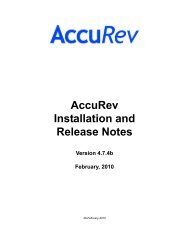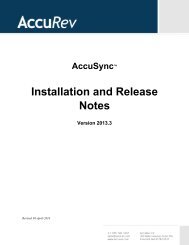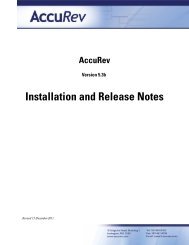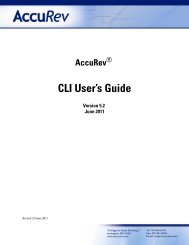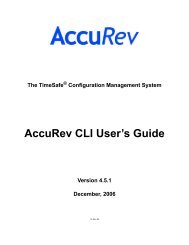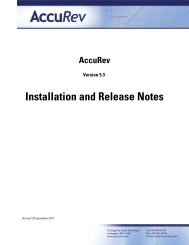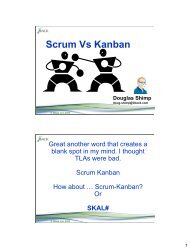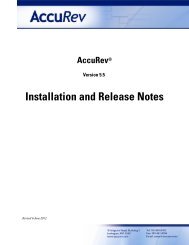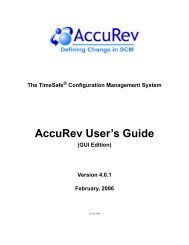Create successful ePaper yourself
Turn your PDF publications into a flip-book with our unique Google optimized e-Paper software.
add<br />
Using Triggers to Control the Element Type and Exclusive File Locking State<br />
Setting of the element type or the exclusive file locking state (or both) can be automated with<br />
triggers. Settings made by triggers scripts override the add -E specifications, if any.<br />
• To set the element type based on file extensions and/or file content, set a pre-operation trigger<br />
with mktrig pre-create-trig. <strong>AccuRev</strong> ships with a sample trigger script, elem_type.pl. You<br />
can customize it to recognize new file suffixes.<br />
• To set the exclusive file locking state on a file-by-file basis, use the server-side pre-operation<br />
trigger, admin_preop_trig.<br />
These triggers are fully described in <strong>AccuRev</strong> Triggers on page 71 of the <strong>AccuRev</strong> Administrator’s<br />
<strong>Guide</strong>.<br />
How <strong>AccuRev</strong> Handles File Elements of Different Types<br />
<strong>AccuRev</strong> handles binary files very simply: when a new binary version is created (with add or<br />
keep), <strong>AccuRev</strong> simply copies the file from your workspace tree to the repository, creating a<br />
storage file. When you retrieve a binary file from the repository (for example, with co -v or<br />
update), <strong>AccuRev</strong> simply copies the storage file to your workspace tree.<br />
Handling of text files is more sophisticated. By default:<br />
• When a new version is created (add or keep), a new storage file is placed in the repository,<br />
with a single NL (or LF) character (hex character code x0A) at the end of each text line. This<br />
means that a version’s storage file may have different line terminators than the file you<br />
submitted to the add or keep command.<br />
• When a text file is copied into the workspace by an <strong>AccuRev</strong> command (e.g. update, pop), it<br />
gets the line terminators appropriate to the machine where the workspace is located: NL (x0A)<br />
for a UNIX/Linux machine, or CR-NL (x0D x0A) for a Windows machine.<br />
On the individual element level, you can override the manipulation of line terminators by<br />
specifying the “preserve text line terminators” element type, with the -E ptext option. Files of this<br />
type are copied to and from the repository with no change, just like binary files.<br />
On the workspace level, you can force the use of a particular line terminator when text files are<br />
copied to the workspace, using the -e option to mkws or chws. This applies to all elements of type<br />
text, but not to elements of type ptext.<br />
How <strong>AccuRev</strong> Converts Existing Links to Link Elements<br />
The add command converts existing link objects with (external) status to <strong>AccuRev</strong> elements as<br />
follows:<br />
• An existing hard link is always converted to an <strong>AccuRev</strong> file element.<br />
• An existing symbolic link (UNIX/Linux) or junction point (Windows) is converted to an<br />
<strong>AccuRev</strong> element-link element (elink) in these circumstances:<br />
• The target is a file element, directory element, or elink in your workspace, and you omit<br />
the -s command-line option. (If the target is an slink, you must use -s to convert the object<br />
to an slink. You cannot create an elink that points to an slink.)<br />
<strong>AccuRev</strong>® <strong>CLI</strong> User’s <strong>Guide</strong> 41




